The 2022 Toyota Tundra Is a Complex Answer to a Simple Question
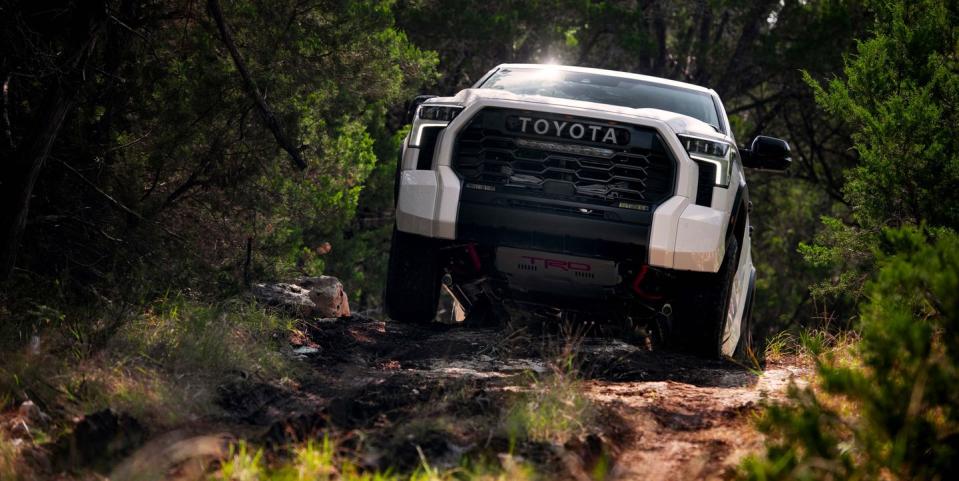
Here’s a number to keep in mind when considering the 2022 Toyota Tundra: Five. That’s the number of heat exchangers sitting in the nose of the new hybrid version of this beastly pickup. That’s one radiator for the engine, two intercoolers (one for each turbocharger), one to keep the hybrid system chilled, and one for the air conditioning system.
The first Toyota truck I ever drove, a 1979 pickup, had exactly one radiator. With a single clutch fan. The new Tundra has two electric fans tasked with pushing air through those layers of cooling fins.
The new Tundra Hybrid 4x4 in TRD Pro trim, may well be the most technologically dense vehicle that Toyota has ever sold in the United States. More complex than even the amazing Lexus LF-A supercar or any of the forklifts. More complex, it seems likely, than any other pickup. And that includes the Rivian R1T or any other all-electric truck. This thing is packing.

This new third-generation Tundra carries over practically nothing from either the first-generation (2000-2006) or second-generation (2007-2021) trucks except the name. Even the lug nuts have been revised, though there are still six on every wheel. Banished to the great CoPart yard in the sky are the renowned V8 engines that have been part of the Tundra mix since the beginning. These are the V8 engines – 4.6-, 4.7- and 5.7-liters in displacement – that have racked up literally a million miles in some single trucks. Engines that slurped fuel but barely feel at all diminished in power or smoothness when there’s 200,000 miles on their clocks. V8s that have set a brilliant standard for truck powerplants. Tough acts to follow.
In the new Tundra, the only internal combustion engine offered is a 3.5-liter, twin-turbocharged, all-aluminum, variable timed, 24-valve V6 that is closely related to the one used in the Lexus LS 500 luxury sedan. While the Lexus engine is assembled in Japan, the Tundra’s version will come out of Toyota’s engine plant in Huntsville, Alabama. It’s the same facility that built the 5.7-liter 3UR-FE used in second-generation Tundras and Sequoias, the 200-series Land Cruiser and the Lexus LX 570. The major difference between the Lexus and the truck version of the new twin-turbo V6 is slightly smaller turbos for better low-end responsiveness and the tuning to match them.
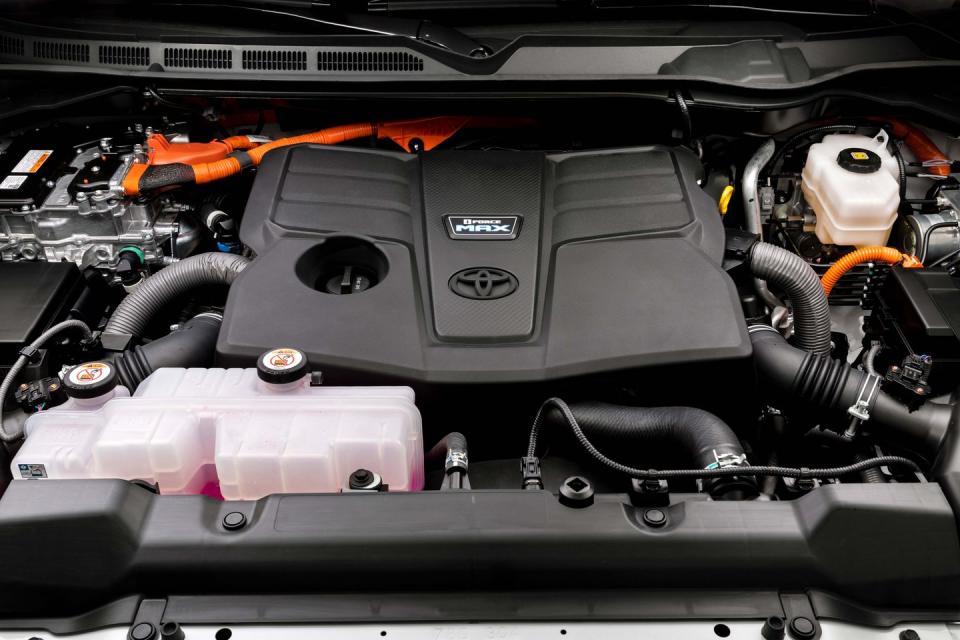
In the Tundra the twin-turbo V6, when left on its own, is rated at 389-hp at 5200 rpm and 479-pound feet of peak torque at just 2400 rpm. That’s a slight bump up from the 5.7 V8’s 381-hp at 5600 rpm and a chunky thump more twist from 401-pound feet at 3600 rpm. The transmission behind it is a ten-speed, Toyota-made automatic similar in concept and construction to that used in the Lexus LS. Seventh gear is a direct 1.00:1 ratio while eighth, ninth and tenth are progressively deeper overdrives. Tenth gear is set at a deep 0.61:1 and the final drive ratio in the rear axle is a modest 3.31:1. That’s a lot of math.
The engine and transmission carry into the “i-Force Max” hybrid intact. The hybrid, electric motor itself is in its own case sandwiched between the V6 and transmission. That whirring thing is rated at 48-hp and 184-pound feet of torque. Combine them together and the result is a claimed 437-hp and 583-pound feet of peak torque at, again, 2400 rpm. Yes, the math checks out.
Incidentally, the LS 500’s turbo V6 rates out at 416-hp and 442-pound feet of torque between 1600 and 4800 rpm. The hybrid version of the LS uses a naturally aspirated 3.5-liter V6 and electric motors unrelated to the Tundra’s system for a total output of 354-hp.
What underpins the new Tundra is an all-new ladder frame it shares with the new Land Cruiser. The frame is fully boxed and uses laser welded sections that precisely and strategically join thicker and thinner metal pieces to reduce mass where the heft isn’t needed. As a frame designed to accommodate both the Tundra pickup and whatever SUVs will be built atop it, the bed of the Tundra is actually mounted to pedestals welded atop the rails.
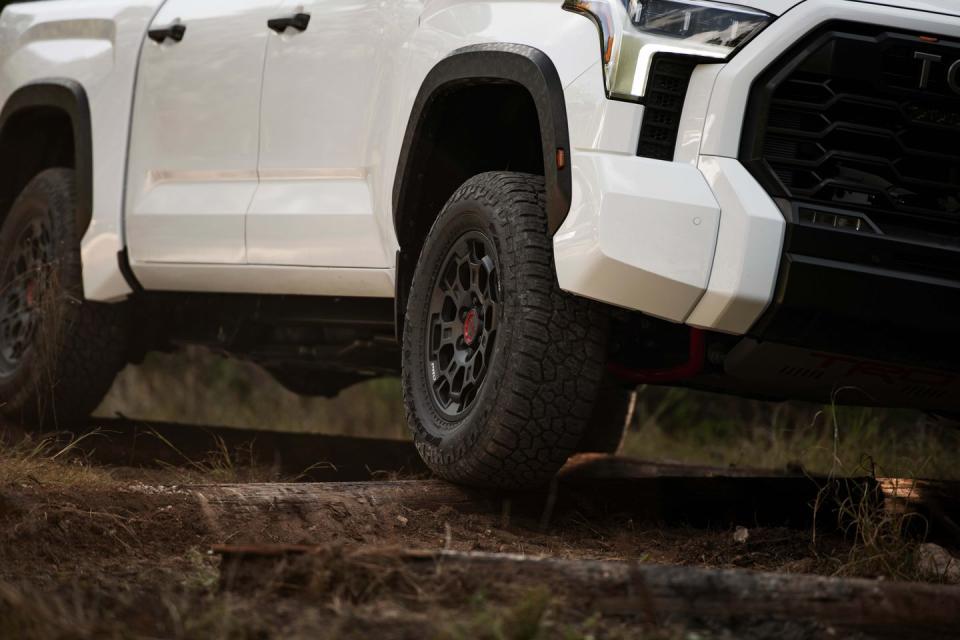
The front suspension isn’t innovative–it’s double wishbones on either side. But the rear suspension is all new and, yes, coil sprung. Similar to the system used in Ram pickups, the multi-link system supports Toyota’s familiar solid rear axle. The coil springs themselves are mounted outside frame rails and there are available different systems for self-leveling and variable dampening. There’s no reason to mourn the semi-elliptical leaf springs of the previous Tundras.
There are two cab configurations available. There’s the Double Cab four-door which works as basically a sedan with a bed. And then there’s the longer CrewMax with an additional 8.3-inches of rear seat leg room, a limousine with a bed. Short bed Double Cabs and CrewMaxes ride on a 145.7-inch wheelbase. Long bed CrewMaxes are on a 157.7-inch wheelbase and long bed Double Cabs get a 164.6-inch wheelbase. The shortest bed, on the 145.7-inch wheelbase CrewMax is only 65.6-inches long – call that 5½ feet. The longest bed, on the 164.6-inch Double Cab is 96.5-inches long – call that eight feet. The standard bed on the Double Cab is 77.6-inches and that’s the long bed on the CrewMax. Got that? Whew.

After all that bed obsession, there’s only so much to say for the six different trim levels – SR, SR5, Limited, Platinum, 1794 Edition and TRD Pro (the model pictured here). And the SR5, Limited and 1794 Edition are also all available with a TRD Off-Road package. Most of these variations get their own front grille too – there are seven grilles in total. Some with chrome, some with satin finishes and some with slats and some with cross hatch patterns. The TRD Pro grille features a supplemental light bar in its center and amber running lights because… well Ford’s Raptor and the Ram TRX have ambers and that’s reason enough.
Toyota lists the Tundra TRD Pro at 81.6-inches wide while the other Tundras are at 80.2. Exactly whether this means the amber lights are legally required is unclear.
Because the new Tundra shares its frame design with the Land Cruiser, it’s narrower than the previous generation. So cramming in all that needs to be between the rails makes for a tight fit. The standard 22.5-gallon plastic fuel tank, for instance, is a convoluted shape to snake round the driveshaft and exhaust system. The 32.2-gallon tank that is optional on the SR5 and standard on higher trims is a longer, even more odd shape.

Assembled together the hybrid system, quite long 10-speed transmission, and two-speed four-wheel drive transfer case extend almost to the back of short wheelbase Tundras. Those get a one-piece driveshaft. Longer wheelbase versions lacking the hybrid or four-wheel drive systems use two-piece driveshafts.
It’s impossible to evaluate all the trims and variations during an introductory press event. But there are some tasty tidbits to be sampled.
Depending on trim, the Tundra gets either conventional instrumentation dials or a display screen. At this point, the conventional instrumentation is actually something worth savoring as screens become ever more common. Whatever the display in front of the driver, there’s a massive 14-inch screen at the dash center that controls loads and loads of functions. Its high visibility and can be manipulated in dozens of ways. As of now, it’s covering the most digital area in the full-size pickup class. Technology like such screens is always progressing and the center of so much hype that it’s getting increasingly difficult to muster up much excitement about it all.
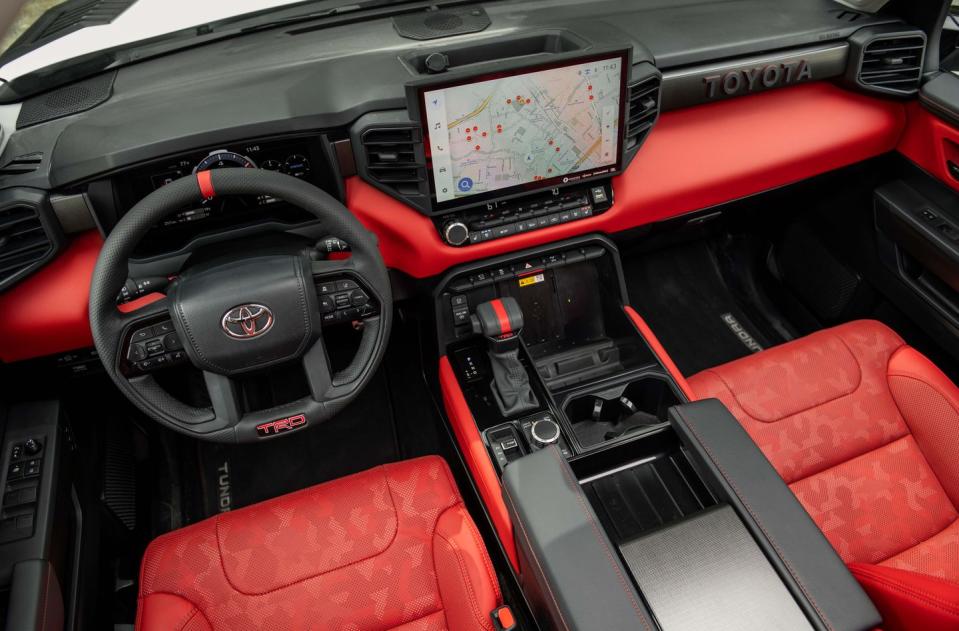
That in mind, every trim of Tundra interior is comfortable with relatively flat seats and tasteful decoration. Maybe it’s just the sheer overwhelming opulence of the upper trims that makes the easygoing, cloth covered SR5 interior so appealing. There’s a trying-too-hard vibe about the new Tundra that’s muted in the lower trims and that translates into something approaching self-actualization. After all, Maslow’s hierarchy of needs doesn’t include a leather lined, Platinum tier.
The interior isn’t quite as elegant as the Ram’s, but clearly ahead of Ford and GM (though we’re yet to see the recently upgraded interior on the 2022 Silverado). Toyota has gone for a large shifter in the center console that takes up some real estate that might be better dedicated to storage or as a work surface. The Ram’s dash mounted rotary shifter isn’t always loved, but at least it’s out of the way. How about a column shifter? Remember those?
Even without the hybrid system, the turbo V6 provides plenty of power. There’s never any turbo lag, the transmission never hunts for a gear and it barely makes any noise. In fact, there’s so little noise that Limited and higher trim models pump in some faux V8 sounds through the JBL branded sound system to add a comforting burble. Maybe peak exhaust note has been reached and now, overshot.
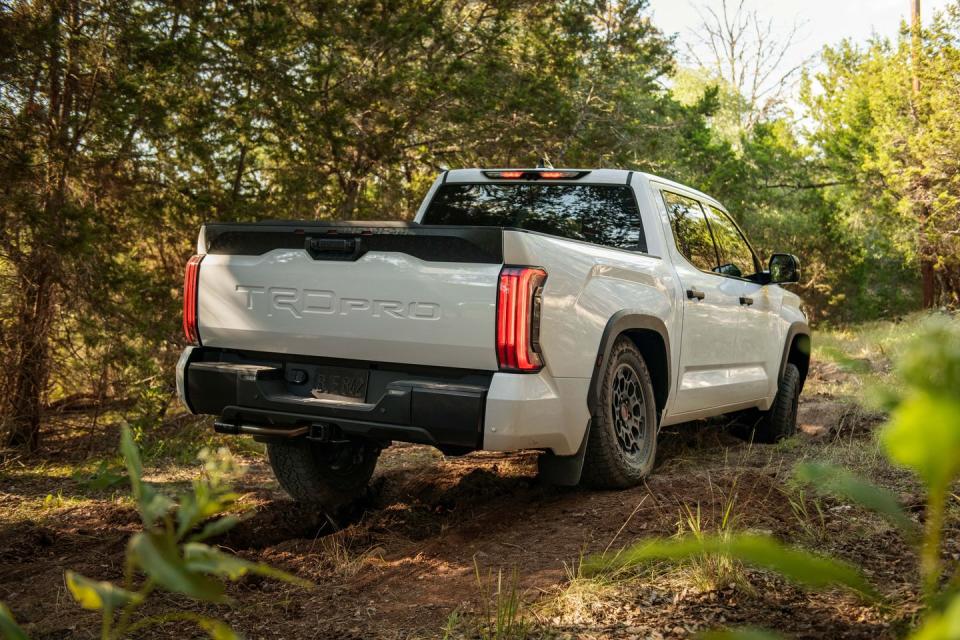
The glamor trim of the Tundra line will be the TRD Pro model which includes a suspension lift kit that adds 1.1-inches more clearance in front, Fox branded remote reservoir shocks and special 18-inch wheels with wider 285/65R18 Falken Wildpeak tires. This is 33-inch tall rubber and there wasn’t anything so challenging on this brief exposure that the TRD Pro could show off all it could do. But now TRD Pro is stamped into the tailgate to ensure that everyone knows it’s the lead husky. The most surefooted and most expensive.
On the road, the best thing about this truly large truck is that it drives significantly smaller than it is. It’s easy to visually landmark the hood so the driver knows where the thing ends. The electric power steering doesn’t offer much feel, but it’s decently quick and always precise.
And despite the enormity of all this, the new Tundra should get decent fuel mileage. Toyota hasn’t offered hybrid fuel economy numbers yet, but predicts the 4x2 model non-hybrid will come in at 18 mpg in the city, 23 mpg on the highway and 20 combined. The 4x4 is predicted at one mpg less on each of those cycles. The V8 powered Tundras were notorious gas hogs, so this could be a welcome change.
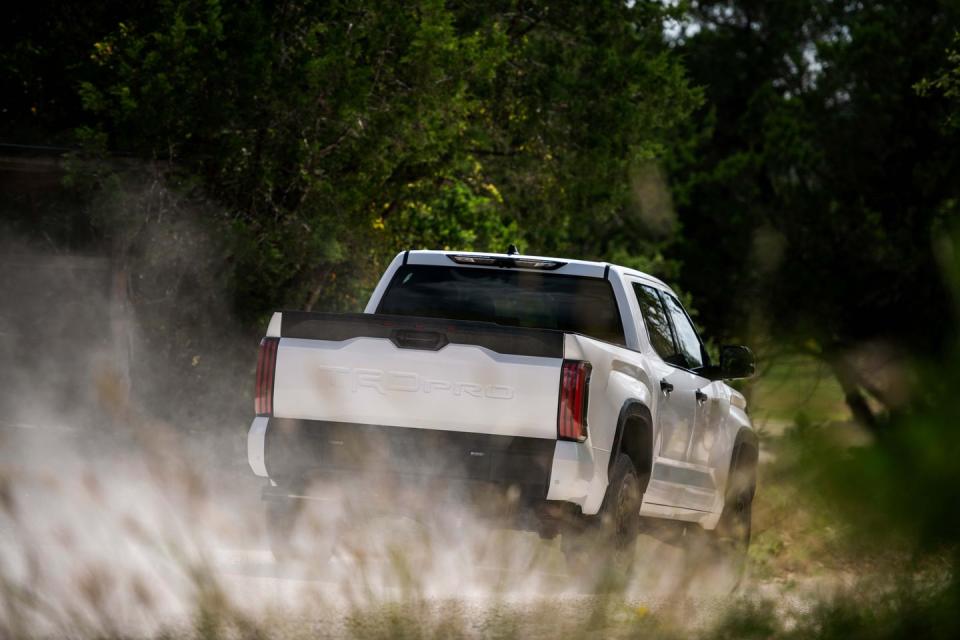
All this in mind, I miss simple Toyota trucks. I currently own two first generation Tundras. A green 2000 SR5 Access Cab I bought in 1999 after returning from the press event launching it. And a black 2006 SR5 Double Cab that I bought as I passed the green one’s care over to my son when he turned 16. They’re both brilliant trucks that work great. And compared to the new Tundra, they seem so primitive. So primitive that it feels like there’s nothing that can go wrong with them. At Toyota, simplicity was once a competitive advantage.
Each of my Tundras have one radiator for the engine and a small one for the air conditioning. That seems like plenty.
You Might Also Like

 Yahoo Autos
Yahoo Autos 